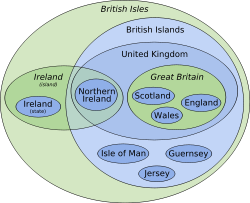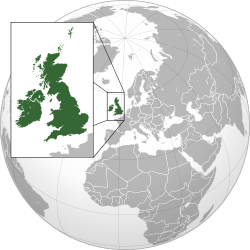British Isles

The British Isles are an archipelago (a group of islands) in north-western Europe. They have a long geographical and geological history.[1] The first people were in Britain by 800,000 years ago (Happisburgh footprints).
The biggest islands are called Great Britain and Ireland, followed by the Isle of Man. Great Britain, the biggest island, is home to three countries. These are England, Wales and Scotland. The island of Ireland is divided into Northern Ireland and the Republic of Ireland. Great Britain is the biggest island of Europe and Ireland is the third biggest.
England, Wales, Scotland and Northern Ireland join together to make the United Kingdom.
Some people include the Channel Islands of Jersey, Guernsey, Sark in the term "British Isles", but they are a lot closer to France than to Great Britain. In politics, they are British islands but in geology they are French islands.
The writings of the Roman cartographer Ptolemy used the name "Great Britain" for the larger island in the 2nd century AD. He used the name "Megale Britannia" or "Great Britain" (Ancient Greek: Μεγάλη Βρεττανία Μegálē Brettanía) to show the difference between this island and Ireland.[2] For Ireland, Ptolemy used the name "Mikra Britannia" or "Little Britain" (Ancient Greek: Μικρά Βρεττανία Mikrá Brettanía).[2]
British Isles Media
The British Isles in relation to the northwest European continental shelf
Some female red deer in Killarney National Park, Ireland
Population density per km2 of the British Isles' regions
Language branches Modern languages Typical spoken locationsEuler diagram showing language branches, major languages and typically where they are spoken for modern languages in the British Isles.
The Alfred Jewel (9th century)
Pádraig Harrington teeing off at the Open Championship (golf) in 2007
References
- ↑ Bennison G.M & Wright A.E. 1969. The geological history of the British Isles. Edward Arnold. ISBN 0-7131-2226-9
- ↑ 2.0 2.1 Bradley, Richard, ed. (2019). "Chapter 1 - The Offshore Islands". The Prehistory of Britain and Ireland. Cambridge World Archaeology (2nd ed.). Cambridge University Press. pp. 1–29. doi:10.1017/9781108419925.001. ISBN 978-1-108-41992-5. S2CID 241252288.
